Datong
Datong is a prefecture-level city in northern Shanxi Province in the People's Republic of China. It is located in the Datong Basin at an elevation of 1,040 metres (3,410 ft) and borders Inner Mongolia to the north and west and Hebei to the east. It had a population of 3,318,057 during the 2010 census, of whom 1,629,035 lived in the built-up area made of the three urban districts of Chengqu, Kuangqu and Nanjiao.
Datong 大同市 Tatung | |
|---|---|
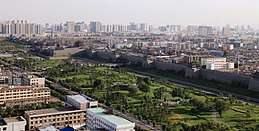      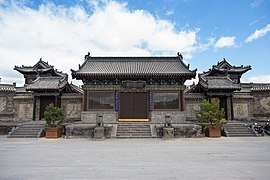  From top down, left to right: Datong panorama; Shanhua Temple; Huayan Temple; Yungang Grottoes; Tower at Lingyan Temple; Temple of Confucius (Wenmiao); Guandi Temple; Yinghui Gate of the City Wall | |
.png) Location of Datong City jurisdiction in Shanxi | |
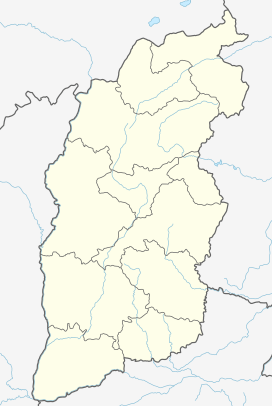 Datong Location of the city center in Shanxi | |
| Coordinates (Datong municipal government): 40°05′49″N 113°22′01″E | |
| Country | People's Republic of China |
| Province | Shanxi |
| Municipal seat | Pingcheng District |
| Government | |
| • Type | Prefecture-level city |
| • Party Secretary | Zhang Jifu |
| Area | |
| • Prefecture-level city | 14,176 km2 (5,473 sq mi) |
| • Urban | 130.20 km2 (50.27 sq mi) |
| • Districts[1] | 2,080.0 km2 (803.1 sq mi) |
| Elevation | 1,042 m (3,419 ft) |
| Population (2010 census) | |
| • Prefecture-level city | 3,318,057 |
| • Density | 230/km2 (610/sq mi) |
| • Urban | 1,259,700 |
| • Urban density | 9,700/km2 (25,000/sq mi) |
| • Districts[1] | 1,610,000 |
| Time zone | UTC+8 (China Standard) |
| Postal code | 037000 |
| Area code(s) | 0352 |
| ISO 3166 code | CN-SX-02 |
| License Plates | 晋B |
| Administrative division code | 140200 |
| Website | dt |
| Datong | |||||||||
|---|---|---|---|---|---|---|---|---|---|
| Chinese | 大同 | ||||||||
| Literal meaning | Great Unity Great Togetherness | ||||||||
| |||||||||
| Former names | |||||||||
|---|---|---|---|---|---|---|---|---|---|
| Pingcheng | |||||||||
| Traditional Chinese | 平城縣 | ||||||||
| Simplified Chinese | 平城县 | ||||||||
| Literal meaning | Peaceful City County Pacified City County | ||||||||
| |||||||||
| Xijing | |||||||||
| Chinese | 西京 | ||||||||
| Literal meaning | Western Capital | ||||||||
| |||||||||
History
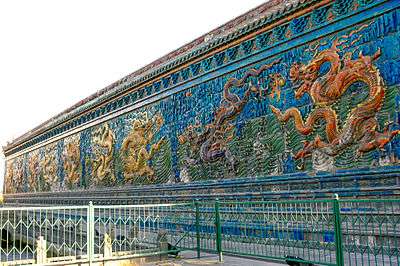
The area of present-day Datong was close to the Beidi ("Northern Barbarian") state of Dai, which was conquered by the Zhao clan of Jin in 457 BC. It was a frontier land between the agricultural Chinese and Beidi and the nomads of the Eurasian steppe (known to the Chinese as the Hu or Donghu). The area was well known for its trade in horses.
Pingcheng County formed part of the Qin commandery of Yanmen.[2] It continued under the Han, who founded a site within present-day Datong in 200 BC following their victory against the Xiongnu nomads at the Battle of Baideng. Located near a pass to Inner Mongolia along the Great Wall, Pingcheng blossomed during the following period and became a stop-off point for camel caravans moving from China into Mongolia and beyond. It was sacked at the end of the Eastern Han. Pingcheng became the capital of Northern Wei from AD 398–494. The Yungang Grottoes were constructed during the later part of this period (460–494). During the mid to late 520s, Pingcheng was the seat of Northern Wei's Dai Commandery.[3]
The city was renamed Datong in 1048. It was the Xijing ("Western Capital") of the Jurchen Jin dynasty prior to being sacked by the Mongols. It was sacked again at the end of the Ming in 1649, but promptly rebuilt in 1652.
Geography
Datong is the northernmost city of Shanxi, and is located in the Datong Basin, with an administrative area spanning latitude 39° 03'–40° 44' N and longitude 112° 34'–114° 33' E. The urban area is surrounded on three sides by mountains, with passes only to the east and southwest. Within the prefecture-level city elevations generally increase from southeast to northwest. Datong borders Ulanqab (Inner Mongolia) to the northwest and Zhangjiakou (Hebei) to the east, Shuozhou (Shanxi) to the southwest and Xinzhou (Shanxi) to the south.
The well-known Datong Volcanic Arc lies nearby in the Datong Basin.
Climate
Datong has a continental, monsoon-influenced steppe climate (Köppen BSk), influenced by the 1,000 metres (3,300 ft)+ elevation, with rather long, cold, very dry winters, and very warm summers. Monthly mean temperatures range from −10.5 °C (13.1 °F) in January to 22.6 °C (72.7 °F) in July; the annual mean temperature is 7.33 °C (45.2 °F). Due to the aridity and elevation, diurnal temperature variation is often large, averaging 13.2 °C (23.8 °F) annually. There barely is any precipitation during winter, and more than 3⁄4 of the annual precipitation occurs from June to September. With monthly percent possible sunshine ranging from 54% in July to 66% in October, sunshine is abundant year-round, and the city receives 2,671 hours (about 60% of the possible total) of bright sunshine per year.
| Climate data for Datong (1981–2010 normals, extremes 1951–2010) | |||||||||||||
|---|---|---|---|---|---|---|---|---|---|---|---|---|---|
| Month | Jan | Feb | Mar | Apr | May | Jun | Jul | Aug | Sep | Oct | Nov | Dec | Year |
| Record high °C (°F) | 11.2 (52.2) |
19.2 (66.6) |
25.3 (77.5) |
35.4 (95.7) |
35.5 (95.9) |
39.0 (102.2) |
39.2 (102.6) |
35.9 (96.6) |
34.7 (94.5) |
27.5 (81.5) |
21.7 (71.1) |
14.6 (58.3) |
39.2 (102.6) |
| Average high °C (°F) | −3.4 (25.9) |
1.4 (34.5) |
8.1 (46.6) |
16.9 (62.4) |
23.5 (74.3) |
27.6 (81.7) |
28.8 (83.8) |
26.7 (80.1) |
22.2 (72.0) |
15.2 (59.4) |
5.9 (42.6) |
−1.6 (29.1) |
14.3 (57.7) |
| Daily mean °C (°F) | −10.5 (13.1) |
−6.0 (21.2) |
0.8 (33.4) |
9.4 (48.9) |
16.4 (61.5) |
20.8 (69.4) |
22.6 (72.7) |
20.6 (69.1) |
15.3 (59.5) |
8.0 (46.4) |
−1.1 (30.0) |
−8.3 (17.1) |
7.3 (45.2) |
| Average low °C (°F) | −16.4 (2.5) |
−12.2 (10.0) |
−5.6 (21.9) |
2.0 (35.6) |
9.0 (48.2) |
14.0 (57.2) |
16.8 (62.2) |
15.1 (59.2) |
9.1 (48.4) |
2.0 (35.6) |
−6.8 (19.8) |
−13.9 (7.0) |
1.1 (34.0) |
| Record low °C (°F) | −29.1 (−20.4) |
−27.6 (−17.7) |
−20.9 (−5.6) |
−15.6 (3.9) |
−5.8 (21.6) |
2.9 (37.2) |
8.8 (47.8) |
6.1 (43.0) |
−3.4 (25.9) |
−10.4 (13.3) |
−24.0 (−11.2) |
−27.6 (−17.7) |
−29.1 (−20.4) |
| Average precipitation mm (inches) | 1.7 (0.07) |
2.5 (0.10) |
9.8 (0.39) |
19.5 (0.77) |
31.0 (1.22) |
47.4 (1.87) |
97.6 (3.84) |
77.1 (3.04) |
55.1 (2.17) |
19.7 (0.78) |
6.0 (0.24) |
1.9 (0.07) |
369.3 (14.56) |
| Average precipitation days (≥ 0.1 mm) | 2.0 | 2.5 | 4.5 | 4.1 | 7.0 | 9.8 | 13.5 | 12.2 | 8.8 | 4.8 | 2.8 | 1.9 | 73.9 |
| Average relative humidity (%) | 53 | 46 | 42 | 38 | 40 | 49 | 62 | 67 | 61 | 54 | 51 | 52 | 51 |
| Mean monthly sunshine hours | 184.1 | 189.4 | 222.3 | 243.5 | 272.5 | 265.7 | 244.8 | 233.9 | 234.6 | 226.8 | 185.8 | 167.5 | 2,670.9 |
| Percent possible sunshine | 62 | 63 | 60 | 62 | 62 | 59 | 54 | 55 | 63 | 66 | 62 | 58 | 61 |
| Source: China Meteorological Administration (precipitation days and sunshine 1971–2000)[4][5] | |||||||||||||
Administrative divisions

| Map | ||||||
|---|---|---|---|---|---|---|
| Name | Simplified Chinese[6][7] | Pinyin | Population (2003 est.)[8] |
Area (km²)[9] | Density (/km²) | |
| Pingcheng District | 平城区 | Píngchéng Qū | 580,000 | 246 | 2,358 | |
| Yungang District | 云冈区 | Yúngāng Qū | 280,000 | 684 | 409 | |
| Xinrong District | 新荣区 | Xīnróng Qū | 110,000 | 1,102 | 109 | |
| Yunzhou District | 云州区 | Yúnzhōu Qū | 170,000 | 1,501 | 113 | |
| Yanggao County | 阳高县 | Yánggāo Xiàn | 290,000 | 1,678 | 173 | |
| Tianzhen County | 天镇县 | Tiānzhèn Xiàn | 210,000 | 1,635 | 128 | |
| Guangling County | 广灵县 | Guǎnglíng Xiàn | 180,000 | 1,283 | 140 | |
| Lingqiu County | 灵丘县 | Língqiū Xiàn | 230,000 | 2,720 | 85 | |
| Hunyuan County | 浑源县 | Húnyuán Xiàn | 350,000 | 1,965 | 178 | |
| Zuoyun County | 左云县 | Zuǒyún Xiàn | 140,000 | 1,314 | 107 | |
- Defunct - Kuang District (Chinese: 矿区; pinyin: Kuàngqū) is largely made up of separate mines throughout the metropolitan area.
Tourism
The Yungang Grottoes are a collection of shallow caves located 16 km (9.9 mi) west of Datong. There are over 50,000 carved images and statues of Buddhas and bodhisattvas within these grottoes, ranging from 4 centimeters to 7 meters tall. Most of these icons are around 1000 years old.
Within the city itself, there are a few surviving sites of historical interest such as the Nine-Dragon Wall, the Huayan Monastery (华严寺; Huáyán Sì), and the Shanhua Temple. Further afield is the Hanging Temple built into a cliff face near Mount Heng. Most of the historical sites in this region date to the Tang and Ming dynasties, but the Hanging Temple dates to the Northern Wei dynasty (386–534).
The railway locomotive works (see below) began to attract increasing numbers of railway enthusiasts from the 1970s. When construction of steam locomotives was phased out, the authorities did not want to lose this valuable tourism market, and pondered the possibility of developing a steam railway operating centre as an attraction. A number of study visits were undertaken to the East Lancashire Railway at Bury, and a twinning arrangement was concluded with that town.
In 2010, work began on reconstructing the city's 14th century Ming dynasty defensive wall. The controversial reconstruction project was in its final phase at the end of 2014.[10] The documentary The Chinese Mayor[11] documents two years of vigorous and highly controversial (due to summary demolition of about 200,000 homes) effort by Mayor Geng Yanbo to push the reconstruction project forward.
 The Hanging Temple
The Hanging Temple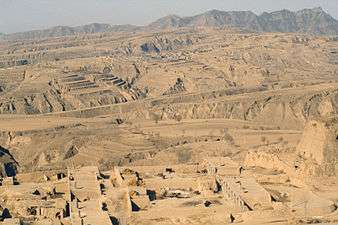
- A tower on the City Wall
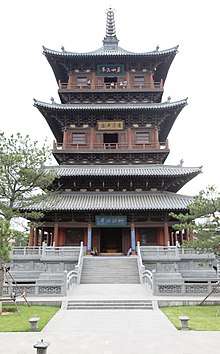 Pagoda at Huayan Temple
Pagoda at Huayan Temple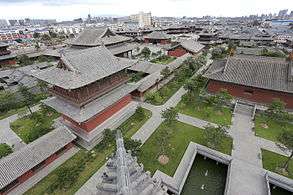 Huayan Temple
Huayan Temple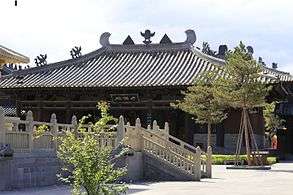 Lingyan Temple at Yungang Grottoes
Lingyan Temple at Yungang Grottoes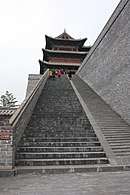 Guard house on Datong City Wall
Guard house on Datong City Wall
Economy
The GDP per capita was ¥17,852 (US$2,570) per annum in 2008, ranked no. 242 among 659 Chinese cities. Coal mining is the dominant industry of Datong. Its history and development are very much linked to this commodity.
Development zones Datong Economic and Technological Development Zone
Due to its strategic position it is also an important distribution and warehousing center for Shanxi, Hebei and Inner Mongolia.[12]
Datong is an old fashioned coal mining city, and still sits on significant reserves of this commodity. Consequently, it has developed a reputation as one of China's most polluted cities. The Datong Coal Mining Group is based here and is China's third largest such enterprise. Datong is indeed however an emerging economy, as the city seeks to loosen its dependence on coal, introduce more environmentally friendly and efficient methods of extraction and move into other areas of business services. Local government has continued to upgrade its pillar coal sector (and related industries like coal chemicals, power and metallurgy), while also developing "substitute industries" such as machinery manufacturing, tourism and distribution, warehousing and logistics services. This has had some impact. Datong's GDP grew by 5.1 percent in 2008 to RMB56.6 billion.[13]
While coal will continue to dominate, Datong has been identified as one of the key cities requiring redevelopment, with part of this being in environmental cleanup, rehabilitation and industrial refocusing. Datong is a pilot city for rehabilitation studies following years of pollution. To this end it has already struck up strong relationships with other cities worldwide with similar backgrounds, and has begun plans, for example, to develop a tourism base focused on steam engine technology with antique locomotives to be used along designated tracks.[14]
Datong has a large railway locomotive works 'Datong locomotive factory', where the 'Aiming Higher' class of steam locomotive was built as late as the 1970s, steam locomotive production ended in the late 1980s and the plants main products (as of 2010) is main line electric locomotives
Main enterprises
- Datong Coal Mine Group (The third biggest coal-mining enterprise in China)[15]
- Datong Electric Locomotive Co., Ltd, (DELC) (The second biggest Elec-Locomotive enterprise in China)[16]
- Shanxi Diesel Engine Industries Corporation, Ltd, CNGC[17]
- Shanxi Synthetic Rubber Group Co., Ltd, CNCC[18]
- GD Power Datong No.2 Power Plant
- GD Power Datong Power Generation Co., Ltd[19]
- Shanxi Datang International Yungang Co-generation Co., Ltd.[20]
- China National Heavy Duty Truck Group Datong Gear CO., LTD[21]
Transportation
- China National Highway 109
- China National Highway 208
- G55 Erenhot–Guangzhou Expressway
- G5501 Datong Ring Expressway
- Datong railway station
- Datong Yungang Airport
Education
Colleges and universities
- Datong University (大同大学)
Major schools
- Datong No.1 Middle School (大同市第一中学)
- Datong No.2 Middle School (大同市第二中学)
- Datong Locomotive Middle School (大同机车中学)
- Datong No.3 Middle School (大同市第三中学)
- BeiYue Middle School (北岳中学)
- Datong Experimental Secondary School (大同市实验中学)
- The No.1 Middle School of DCMG (Datong Coal Mine Group) (同煤一中)
- Datong No.14 Elementary School (大同市第十四小学)
- Datong No.18 Elementary School (大同市第十八小学)
- Datong Experimental Elementary School (大同市实验小学)
References
Citations
- Ministry of Housing and Urban-Rural Development, ed. (2019). China Urban Construction Statistical Yearbook 2017. Beijing: China Statistics Press. p. 46. Retrieved 11 January 2020.
- Hou Xiaorong (2009), 《秦代政区地理》 [An Atlas of Qin-Era Administrative Divisions], Beijing: Social Science Academic Press. (in Chinese)
- Xiong (2009), s.v. "Daijun".
- 中国气象数据网 - WeatherBk Data (in Chinese). China Meteorological Administration. Retrieved 15 April 2020.
- 中国地面国际交换站气候标准值月值数据集(1971-2000年). China Meteorological Administration. Archived from the original on 21 September 2013. Retrieved 25 May 2010.
- 2016年统计用区划代码. National Bureau of Statistics of the People's Republic of China.
- http://www.sxdt.gov.cn/dtzww/lsyg/zjdt_lsyg.shtml
- 大同市历史沿革_行政区划网(区划地名网) www.xzqh.org. XZQH.org.
- 山西省大同市地名介绍. www.tcmap.com.cn.
- "Fake it to make it". South China Morning Post Magazine. Hong Kong. Retrieved 2 November 2014.
- "The Chinese Mayor". IMDb.
- China Briefing Business Guide. China-briefing.com. Retrieved on 25 February 2014.
- "2008 Datong Economy Report".
- China Briefing Business Guide: Datong Economy. China-briefing.com. Retrieved on 25 February 2014.
- 大同煤矿集团公司. Datong Coal Mine Group. Retrieved 25 February 2014.
- Datong Electric Locomotive Co.,Ltd Of Cnr Archived 30 July 2012 at Archive.today. Dtloco.com. Retrieved on 25 February 2014.
- Archived 10 February 2005 at the Wayback Machine
- Archived 17 April 2009 at the Wayback Machine
- Archived 3 October 2011 at the Wayback Machine
- Www.China-Cdt.Com Archived 12 March 2008 at the Wayback Machine. Www.China-Cdt.Com (29 December 2002). Retrieved on 25 February 2014.
- china national heavy duty truck group datong gear co ltd. Dcgroup.com.cn. Retrieved on 25 February 2014.
Bibliography
- Xiong, Victor Cunrui (2009), Historical Dictionary of Medieval China, Historical Dictionaries of Ancient Civilizations and Historical Eras, No. 19, Lanham: Scarecrow Press.
Further reading
- Cotterell, Arthur (2008). The Imperial Capitals of China: An Inside View of the Celestial Empire. Pimlico, London. ISBN 978-1-84595-010-1.
External links
| Wikimedia Commons has media related to Datong. |

- Official website
